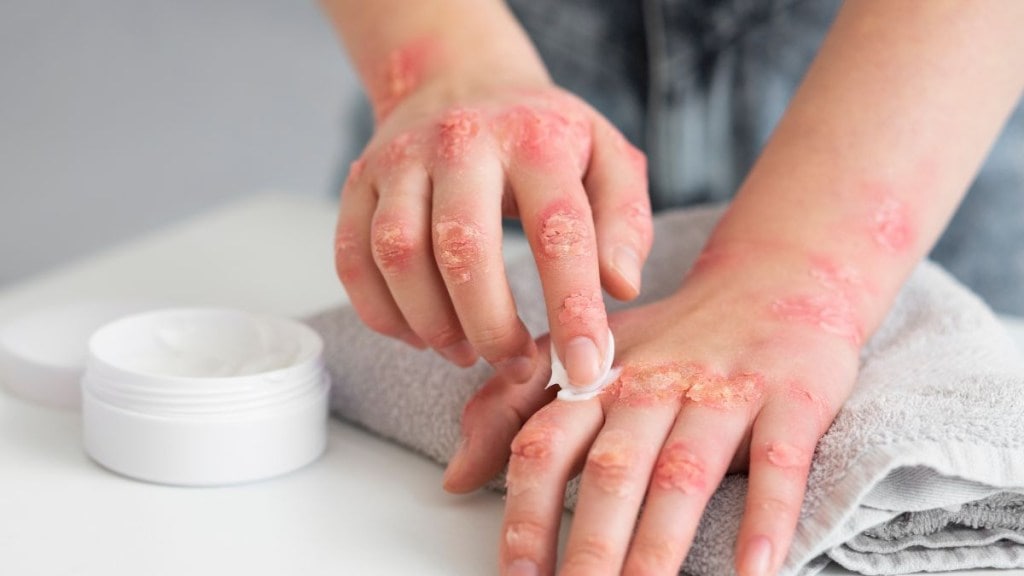A 32-year-old woman walked into the outpatient department (OPD) at the National Skin Hospital in Panchkula with multiple itchy skin lesions on her abdomen, thighs, and face. Her nails had also turned discoloured. When the problem began five months ago, she tried home remedies but found no relief. On a chemist’s advice, she applied steroid-based creams. The itching eased briefly, but the rash grew redder, her skin became thinner, and scarring appeared.
Dr. Vikas Sharma, Head of Dermatology at National Skin Hospital, told The Indian Express, “What she had was a routine fungal infection. You should not use steroid medication at all. While steroid creams can temporarily reduce itching, they worsen fungal infections by suppressing the immune system. This allows the fungus to spread and makes the infection more severe.” With proper antifungal medicines, her skin cleared up in 45 days.
Why do fungal infections rise in the monsoon?
Dr. Sharma explained to The Indian Express, “Fungi prefer a warm, moist environment. That’s why infections increase during the summer and monsoon. Excessive sweating combined with humidity creates ideal conditions for fungal growth.”
The most common fungal infection, according to Dr. Vikas Bhutani, Director of Internal Medicine at Fortis Hospital, Mohali, is athlete’s foot, which usually appears between the toes as a red, circular rash. He told The Indian Express, “We also see jock itch in the groin area and yeast infections under the arms, breasts, or groin folds. Fungus doesn’t spare the nails either, making them thick, brittle, and discoloured.”
Common signs of fungal infections
- Itchy red rashes
- Discoloured or thickened nails
- White patches on the skin
- Skin irritation or lesions that worsen with scratching
- Recurrent cough or breathing issues in rare cases
Doctors warn that ignoring early signs can allow the infection to spread further, sometimes to internal organs like the lungs, in vulnerable individuals.
Skin hygiene is key
During monsoon, skin care plays a crucial role in preventing fungal growth. Dr. Bhutani explained to The Indian Express, “Taking a bath at least twice a day is beneficial. Change into dry clothes and shoes quickly after getting wet. Dry your feet thoroughly, especially between the toes. Wear loose cotton or linen instead of synthetic fabrics. Use antifungal powders in areas prone to sweating. And don’t forget sunscreen — during monsoon, ultraviolet rays can be even more damaging.”
Monsoon also fuels ENT infections
It’s not just the skin that’s affected. Dr. Raghav Mehan, Senior Consultant, ENT, Paras Health, Panchkula, told The Indian Express that he has seen a 20 per cent rise in fungal ear infections, nasal allergies, and throat irritation this monsoon. “A damp indoor environment and poor ventilation are key triggers. They worsen nasal blockages, throat discomfort, and fungal ear infections,” he said.
Doctors also warn against sharing clothes, bedsheets, and towels, as these can spread infections among family members. Dr. Sharma recommended to The Indian Express, “Include probiotic-rich foods like yoghurt, fermented dishes, and kefir in your diet to boost immunity. Avoid highly processed and sugary foods, which may encourage fungal growth.”
Can fungal infections affect the lungs?
While skin and nail infections are more common, prolonged humidity can also raise the risk of fungal infections in the lungs. Dr. Sonal, Consultant, Pulmonary Medicine, Livasa Hospital, Mohali, told The Indian Express, “Though fungal pneumonia is less common, we see more cases of pulmonary aspergillosis during monsoon. It can cause wheezing, cough, fever, or even blood in sputum, especially in those with weak immunity or lung disease.”
She added, “If you notice blood in sputum or persistent breathing issues, consult a doctor immediately. Early detection prevents complications.”
When to see a doctor
Experts told The Indian Express that medical help should be sought at the first signs of fungal infection. Self-medication or incomplete treatment increases the risk of resistance to antifungal drugs.
Dr. Sharma warned, “With rising resistance among fungal organisms, it’s important to complete the full antifungal treatment. Stopping midway or using the wrong creams only worsens the condition.”
With humidity rising during the monsoon, fungal infections are spreading faster. Doctors say good hygiene, timely medical attention, and avoiding self-medication are the best defences. If you notice itching, unusual rashes, or breathing problems, don’t ignore them, get checked before the infection worsens.







